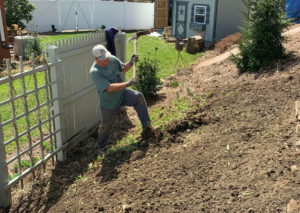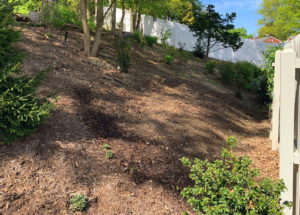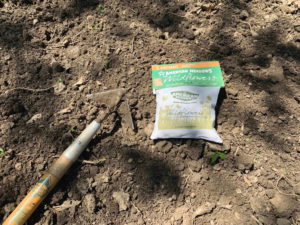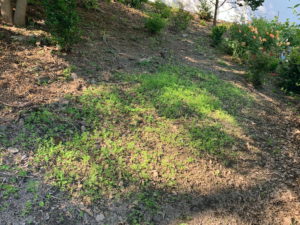The Mini-Meadow Project
June 7th, 2022
I’ve always had doubts about meadows.

George grubbing deep-rooted weeds out of the future mini-meadow with a mattock.
Proponents of this buckshot-planted, multi-species idea tout meadows as an exceptionally low-care way to cover a lot of ground colorfully while being friendly to pollinators and the ecosystem.
The cynical side of me pushes the too-good-to-be-true button and wonders whether weeds will be the ultimate winner.
After all, I’ve heard a fair number of meadow-failure stories over the years, including poor seed germination, a shrinkage down to just one or two dominant species after a few years, and “misbehaved seeding,” which can include meadow seeds blowing into unwanted areas as well as weed seeds blowing into the meadow.
Not everyone is happy with the somewhat-wild look either – not the least of which is neatnik neighbors who see the effort as reason to call the code-enforcement officer.
For all of those reasons, a meadow is one of the few kinds of gardens I’ve never planted.
Until now.
I’ve been battling a rather large bank in back of my house for nearly four years now. More accurately, it was a hillside jungle when we moved in.
A previous owner sometime in the distant past made an attempt to tame it with landscape timbers, stone walls, and plantings of wintercreeper euonymus, tawny daylilies, miscanthus grass, evergreens, and apparently some roses and spireas.
But for at least 10 years before we moved in, the bank went untouched. Neighbors told us the most recent owners rarely went outside while they lived there and were cited at least twice by the borough for not even cutting the grass.
I started to tackle the neglected mess by removing weed vines that had grown 40 feet up into the Scotch pine trees, followed by cutting down dead trees and digging out massive amounts of weeds.
After the grand uncovering, I found remnants of rotted timbers and scattered wall stones that had long ago slid down and been semi-buried by eroding soil.
A single spirea, a single red rose, and a vine-smothered Hinoki cypress were the only worthy plants left on the whole 100-foot-wide bank, which ranges from about 25 to 40 feet deep.
Read more about George’s horrific dejungling effort
Over the past two years, I planted the left end with a combination of small trees, evergreens, shrubs, and catmint and converted the right end into a storm-water rock channel flanked by David Austin roses, a triangular trio of native Li’l Ditty dwarf viburnums, and a band of gold-leafed ‘Baggesen’s Gold’ box honeysuckles.

This recycled fencing, planted with red hibiscus, black-eyed susans, and other warm-colored perennials, is designed to hide the middle part of the bank.
That left the middle of the big bank – the part I’ve tried to hide up to now by erecting 12 feet of wooden fencing across the bottom and fronting it with a perennial garden.
The bank here has a mulberry tree that I decided to keep because it helps to screen the neighboring house atop the hill. A woodpile and a planting of arrowwood viburnums, hostas, and white wood asters now cover the top half of this middle section.
All that’s left to finish the bank “reclamation” is the bottom half of the middle section. And that’s where I’m giving a meadow a shot – actually more of a “mini-meadow.”
The space here is about six feet deep and 20 feet across. Since the uncovering, it’s been filled mostly by tawny daylilies, survivor euonymus vines, and assorted perennial weeds.
I figured a mini-meadow might make sense here for a few reasons.
One is that I really want to keep work on this steep bank to a bare minimum. That’s not easy at any age, but it gets even harder with Medicare-grade knees.
Second, I’ve spent so much on plants everywhere else that I liked the idea of investing just a few bucks in seed vs. more costly trips to the garden centers. (Plants have become a lot more expensive lately!)
Third, the soil on the bank is heavy clay, very hard to dig, and a death trap for all but the toughest of species. Planting multiple species hedges my bet.

I’m hoping a mini-meadow here will turn out to low-care and mulching-free.
Fourth, I’m trying to hold down the future job of mulching as much as possible. A meadow – if successful – doesn’t need it.
And fifth, I thought this would be a good time and place to find out first-hand if meadows really are viable, low-care options or whether they sound better than they really turn out to be.
I did enough research to conclude that the bed-prep stage is the most important step in making a meadow work.
So I got out my mattock and grubbed out every weed and piece of tawny daylily root that I could find.
If you’re not familiar with tawny daylily, it’s a gangly, wild-growing type of daylily that blooms orange for a couple of weeks in early summer and can often be found growing in roadside ditches. Clusters spread quickly and thickly to make a death-defying colony that chokes out most everything in its path, which is why it’s on the state’s invasive-plant watch list.
Read more about invasive plants of Pennsylvania
Once I cleared the bed as best as I could, I used what I call the “sucker-punch” strategy. That means that instead of planting right away, I waited a month to see what weeds popped up.
Then I cultivated that mix of new weeds with my long-handled weeding tool, eliminating at least the top-most layer of the weed-seed bank that otherwise would’ve germinated along with my meadow seed.
Seed selection also is important. I’ve heard bad stories about bargain packets and those “meadows in a can” that offer inferior or poorly adapted species.

This pack of American Meadows seed cost way less than trying to plant the bank with shrubs and perennials.
I whittled my choices down to two respected companies that specialize in meadow seeds – Ernst Conservation Seeds of Meadville, Pa., and American Meadows of Vermont.
The mix I chose was American Meadows’ Northeast Wildflower Mixture, which is a blend of 27 different species. A quarter-pound bag of seed cost just $8.76 (plus $8.29 to ship).
It includes native perennials such as lance-leaf coreopsis, purple coneflowers, gaillardia, and black-eyed susans as well as annuals for first-year color and future reseeding, such as cornflowers, cosmos, larkspur, and poppies.
As instructed, I mixed the seed with sand to scatter it across the bed and lightly tamped it in. With most meadow seed, you don’t want to plant it deeper, which is a main reason for poor germination.
I then began watering daily. Keeping the surface consistently damp is also really important for good germination.

Here’s what the newly seeded meadow looked like as of last week, after about three weeks.
Within five days after my May 9 seeding, the first seeds were emerging.
By last week, multiple species were up, and the area was looking mostly green and starting to put on growth.
So far, so good. I’ll keep you posted on how things go.
In the meantime, I’d be interested in hearing your experience if you’ve ever tried a meadow. Email me what you’ve found at george@georgeweigel.net.







